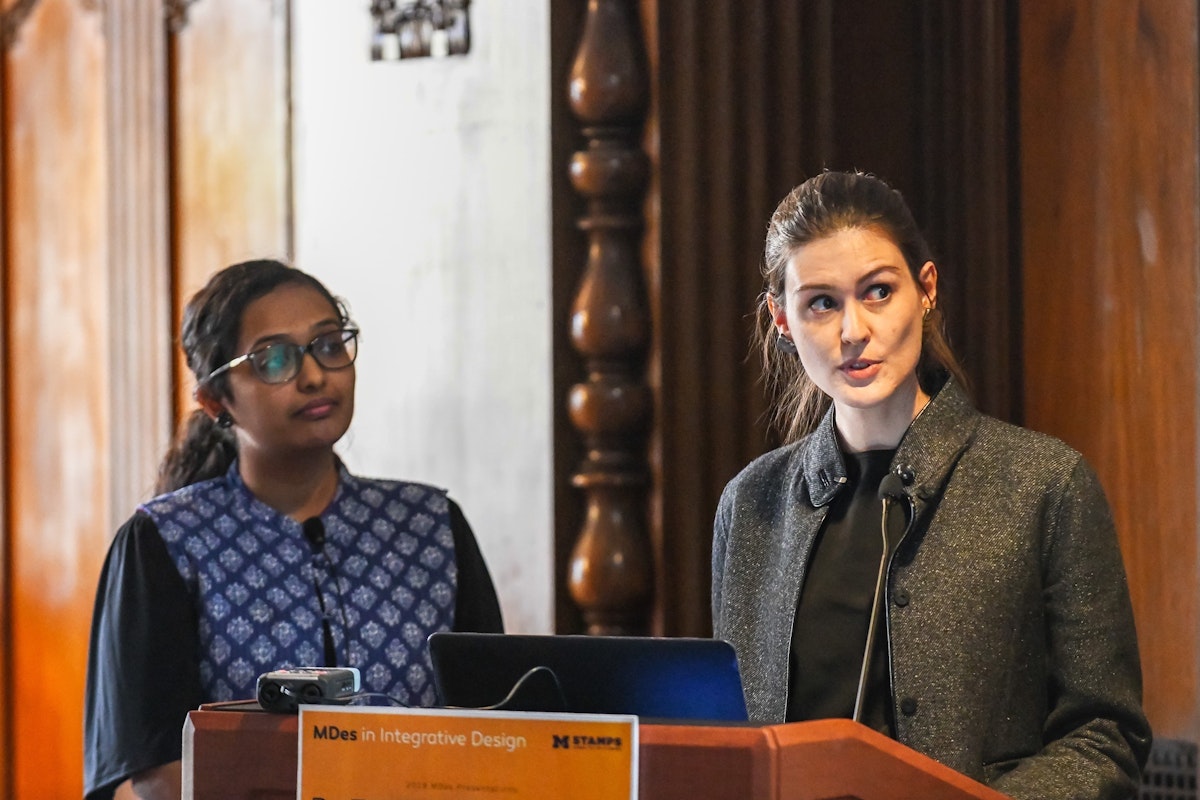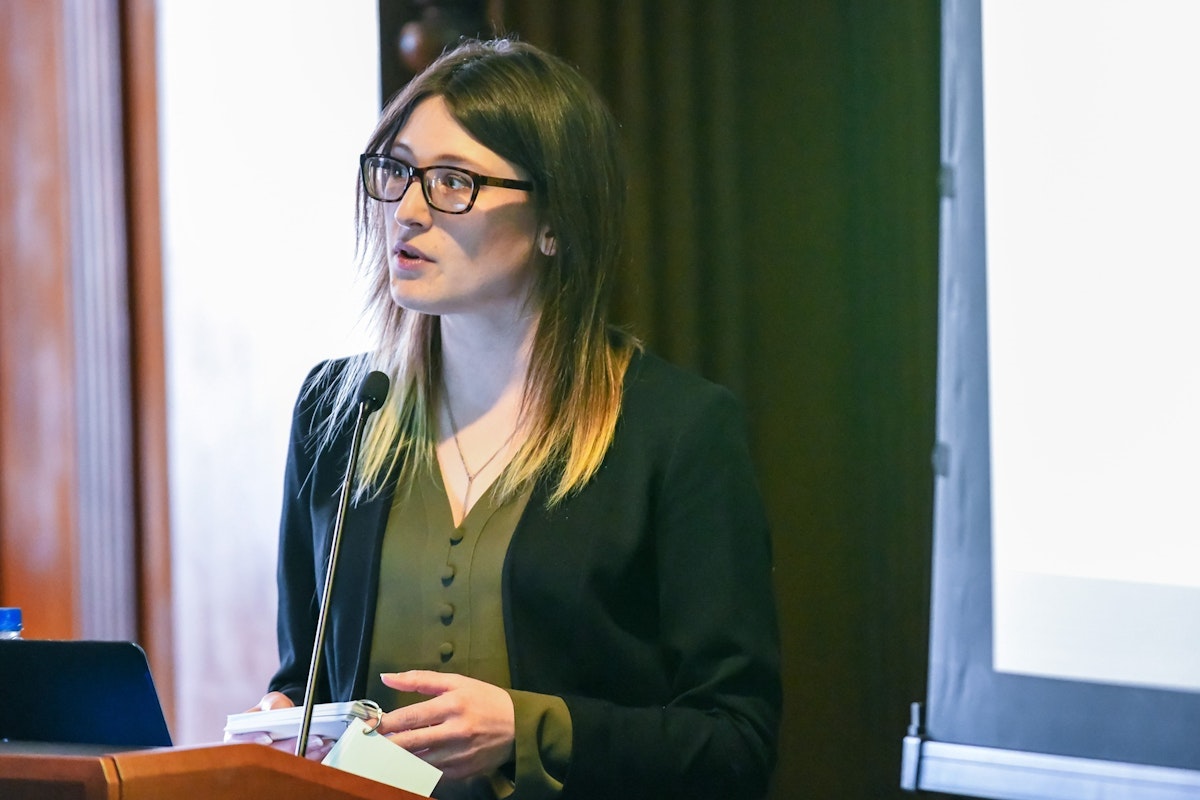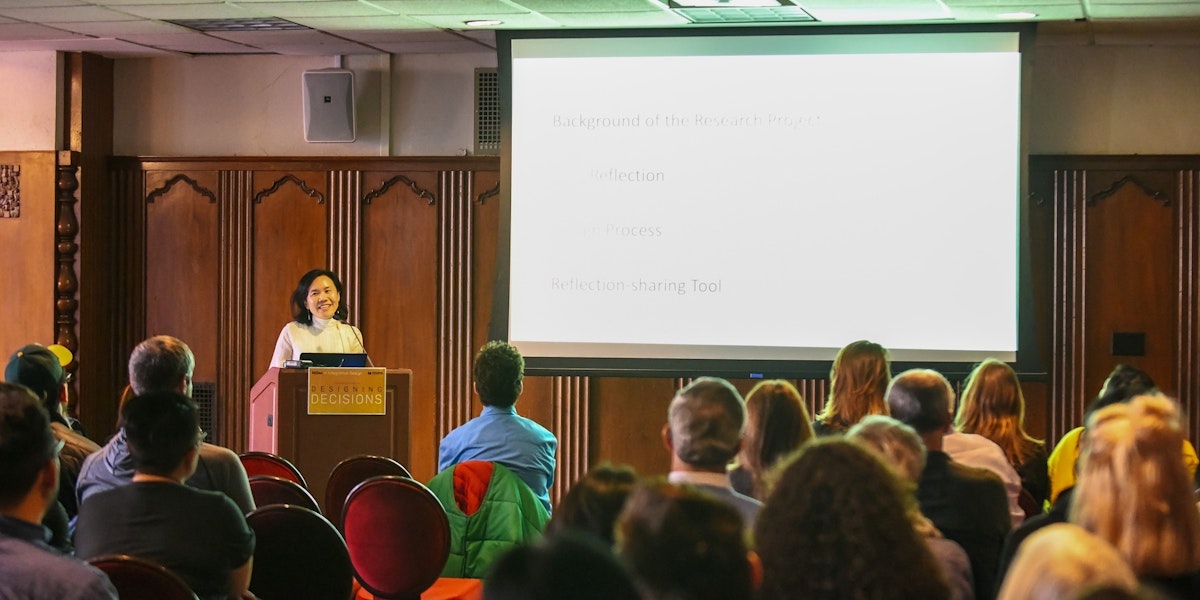Designing Decisions: 2019 MDes Public Talks
Care providers, patients, and policymakers face a near-infinite number of big choices when it comes to managing healthcare.
Graduate students from the third graduating class of the Stamps Master of Design in Integrative Design (MDes) program spent the last four semesters working on addressing appropriate care in healthcare settings, including ways to support healthcare decision-making processes through design. The students presented their research, observations, and interventions during "Designing Decisions," an evening of four public talks held at the Michigan League on March 22, 2019.
At the end of the night, Stamps professor Hannah Smotrich addressed the students and their industry and academic partners and peers in attendance."The heart of this program really is about being out in the world,” she said. “It’s about talking, engaging, and doing what we can to address some of these complex and multifaceted problems."
For Prachi Bhagane and Bruna Oewel (MDes '19), that problem has been reducing Michigan's growing opioid addiction crisis by cutting down on the number of excess prescription opioids in circulation.

The students worked with Dr. Sawsan As-Sanie, an obstetrician and gynecologist at Michigan Medicine, who is piloting a new shared decision-making tool to help doctors and patients make postoperative medication decisions with the goal of reducing prescription opioids. Through their research, Bhagane and Oewel found patients are often ill-informed about pain management options while also overwhelmed by the prospects of their surgery and recovery. As a result, patients often ask for as many opioids as allowed, because they are nervous about pain. Even if they never use them all, the pills are already out there, where it’s easier for them to become a problem.
"We started thinking, 'How might we support the interaction between patients and care providers in order to tailor their pain management decisions to their individualized needs,'" Bhagane said.

Through extensive interviews and observations, Bhagane and Oewel concluded patients need to have expectations set about not only what kind of pain they can expect, but also the variety of ways it can be treated. Next, they need time to think about their options. And last, they need consistent information from start to finish, so even if they only receive brief instructions, whether it's during an initial consultation or at discharge, the message is the same.
"We cannot change the amount of time providers have available, but we can support patients to feel empowered to ask questions of providers and make decisions together about their pain management," Oewel said.

To help with this, they designed a set of three printed handouts given at different stages of the surgical process. The first handout was designed for learning about and reflecting on pain management options and potential side effects before surgery. The second handout helps patients and caregivers review the information and make a decision about pain management at the time of the surgery. The third handout is for the patient to take home with them to help guide their pain management plan and tapering the use and disposal of extra pills.
The simple, printed handouts were chosen for their accessibility, especially for older patients, but Bhagane and Oewel have also had conversations about including similar "surgical journey" mapping tools that could be included as part of a bigger online or mobile application.
Using her background as a UX and UI designer, Kady Jesko (MDes '19) partnered with a quality control division within Michigan Medicine's Pathology Department to create two prototypes for a dashboard that could help providers visualize their decision-making process while ordering medical tests.

The prototypes provided additional context about the tests being considered (such as how long a test might take to fulfill or how much it might cost) and the patients being treated (such as how often they were poked with a needle or woken from sleep). For Jesko, the aim of the prototypes was to develop a way to visualize the test ordering process through design in an effort to help providers consider tests from the clearest vantage point possible and better understand the trade-offs.
Hyeryoung Kim's (MDes '19) thesis work on helping patients manage type 2 diabetes was also about raising consciousness, but on a more personal level.

During her talk, Kim outlined what could be a common scenario for someone living with type 2 diabetes, a disease many Americans currently live with or are at risk for. Kim's design persona (based upon research to represent a typical patient) works in a busy office. On this day, he's had trouble making time for lunch, finding a healthy afternoon snack, not feeling left out when coworkers celebrate with cake, and taking his daily walk because it's raining. As a result, his glucose levels go up, making him frustrated and angry. And this is just one bad day.
"A person with diabetes has these pain points several times a day," Kim said. "Imagine if it continues for weeks, months, years, and decades."
So Kim asked, "How might we design a self reflection tool that can support people with diabetes to increase their motivation and engage their own diabetes activity?"
Working with a group of patients, care providers, educators, and designers, Kim developed a packet of materials to encourage patients to reflect on and express their emotions as part of managing their disease. The "Health, Happiness, and Me" packet includes a journal with a few simple prompts and encouraging words from other diabetes patients; sticky notes and other reminders for tasks like eating, taking medicine, and staying active; and an information card on the link between emotional expression and good metabolic health.
Kim tested the packet with patients and modified it based on their feedback. Many had positive things to say about how the journal helped them make better eating choices, remember to exercise, and even start conversations with doctors.
By using the stories and experiences of patients, Kim said she hoped to inspire and motivate them by presenting a tool that was made with them in mind.
Katherine Jones’ (MDes '19) thesis was also focused on keeping an often marginalized group of people engaged, but at the public policy level.

Instead of focusing on personal healthcare or decisions made in a medical setting, Jones set out to help bridge communications between young people and legislators through design. To do this, she partnered with Michigan Medicine's Dr. Tammy Chang and the team behind MyVoice, a text-message based survey tool Chang developed to gather input from young people age 14 to 24. Started last year, the program has 200 youth participants in Washtenaw County and 1,800 nationwide today.
Jones also talked with local policymakers, youth organizations, and government agencies to learn what issues they're currently working to address. After learning the Washtenaw County Health Department and the Community Mental Health Board were both looking at ways to address a rising adolescent mental health crisis, she decided to focus there. Jones worked with the MyVoice team on a new set of questions around mental health and then scoured the responses for common themes. The big thing that stood out was social stigma as being at the "root of everything happening."
While policymakers are often interested in the data and anecdotes collected by MyVoice, Jones said many are unsure what to do with it, in part, because of how it gets presented to them; valuable insights get lost in nondescript "one-pager" or "white paper" — the industry standard — styled reports.
"It's too text heavy, it's not easy to digest, it doesn't fit in their workflow," she said. "It's missing storytelling and narrative. Any advocate who works in this space knows that personal stories are what moves the needle."
So Jones created a more visual representation of the data that also explained the major warning signs of mental health issues. Using the text messages themselves, Jones' new policy brief format demonstrates the difference between a young person who is thriving and one who isn't by juxtaposing them together. The result: readers are drawn in and want to know more, asking themselves, "How many kids in my community aren't thriving? Now that I know the components, how do I help them along in achieving them?"

In addition to raising questions, the briefs also present readers with a series of probing questions to get them thinking about the consequences of inaction. But Jones said the goal isn't to lead them to any one answer or tell them what to do.
"It's to say, 'There's a mental health crisis, here's what youth are thinking and saying about it, and here's a document that can help you ask questions and think about it — to bring your own knowledge of your own community to think about the right direction,'" Jones said.